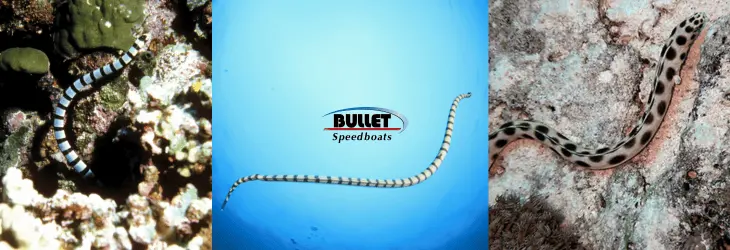Red Sea Snake or Spotted Snake Eel? Meet the Red Sea’s Mysterious Serpents
If you’ve ever snorkeled or swum in the Red Sea, you might have seen a long, snake-like creature gliding across the sand and wondered:
Is that a sea snake, or something else?
The Red Sea is home to some truly mysterious serpents, but not the venomous sea snakes you might expect. Instead, you’re likely seeing the fascinating spotted snake eel, a harmless and intriguing resident of these waters.
Here’s your complete guide to telling them apart and understanding their role in the Red Sea ecosystem.
Are There Sea Snakes in the Red Sea?
There are no true sea snakes in the Red Sea. True sea snakes (family Hydrophiidae) are found mainly in the Indian and Pacific Oceans, but the unique salinity and environmental conditions of the Red Sea keep them away.
The snake-like creatures you see here are spotted snake eels and their relatives, non-venomous, fascinating fish that have evolved to look just like snakes.
Meet the Spotted Snake Eel
The most commonly encountered “serpent” in the Red Sea is the spotted snake eel (Myrichthys maculosus), also known as the tiger snake eel or ocellate snake eel.
This eel is easily recognized by its long, slender body covered in bold black spots on a pale yellow or cream background.
It can grow up to 1 meter long, and its pointed head gives it a true “serpent” look. The spotted snake eel’s appearance is a clever mimicry, helping it avoid predators by resembling dangerous sea snakes found elsewhere.
Spotted Snake Eel vs. True Sea Snake: Key Differences
Found in Red Sea
- Spotted Snake Eel: Yes
- True Sea Snake: No
Venomous
- Spotted Snake Eel: No
- True Sea Snake: Yes
Breathing
- Spotted Snake Eel: Uses gills like fish
- True Sea Snake: Uses lungs and must surface for air
Behavior
- Spotted Snake Eel: Shy, burrowing, nocturnal
- True Sea Snake: Active, sometimes aggressive
Danger to Humans
- Spotted Snake Eel: Harmless
- True Sea Snake: Potentially dangerous
Habitat and Distribution
Spotted snake eels are widespread throughout the Red Sea, from Hurghada’s shallow lagoons to sandy bottoms near coral reefs.
They prefer sandy or muddy areas where they can easily burrow and hide during the day.
You might also find them at reef edges or in calm lagoons, usually at depths from just a few meters down to 30 meters or more.
These eels are nocturnal, spending daylight hours hidden and emerging at night to hunt.
Behavior and Diet
Spotted snake eels are ambush predators, relying on their sense of smell to locate prey. At night, they glide across the sand searching for small fish, crabs, shrimps, and other crustaceans.
When threatened, the spotted snake eel quickly buries itself in the sand, leaving only its head exposed. Its snake-like appearance is a clever defense, warning would-be predators to stay away.
Other Snake Eel Species in the Red Sea
While the spotted snake eel is the most famous, the Red Sea is home to several other snake eel species, including:
- Marbled snake eel (Callechelys marmorata): Brownish with marbled patterns.
- Banded snake eel (Myrichthys colubrinus): Yellow and black bands, often mistaken for a sea snake.
- Ringed snake eel (Ophichthus bonaparti): Pale with dark rings.
Each species has unique markings, but all share the same burrowing, nocturnal lifestyle.
Are Spotted Snake Eels Dangerous?
Spotted snake eels are not dangerous. They are not venomous and are very shy, preferring to avoid humans.
Their resemblance to sea snakes is a form of mimicry that protects them from predators, not a threat to people.
If you spot one, observe from a respectful distance and enjoy the rare sight.
How to Spot a Spotted Snake Eel
Want to see a spotted snake eel in the wild? Here’s how:
- Look in sandy areas near coral reefs, especially at dusk or during night snorkeling.
- Watch for movement: Eels often glide just above the sand or poke their heads out from burrows.
- Night snorkeling increases your chances, as these eels are most active after dark.
- Move slowly and quietly to avoid startling them; they’ll quickly disappear into the sand if alarmed.
Conservation and Ecological Importance
Spotted snake eels play an important role in the Red Sea ecosystem. As predators of small fish and crustaceans, they help keep populations balanced.
They’re not currently considered threatened, but like all marine life, they rely on healthy reefs and clean waters. Responsible snorkeling and diving, never touching or disturbing wildlife, helps protect these fascinating creatures for future generations.
Related Adventures in the Red Sea
Want to spot a spotted snake eel or other unique marine life? Join a private speedboat snorkeling trip with Bullet Speedboats and explore the best reefs and sandy lagoons near Hurghada.
For more fascinating creatures, check out our guides on Types of Fish in the Red Sea, Red Sea Marine Life, and Dangerous Fish of the Red Sea.
Conclusion
The next time you’re snorkeling in Hurghada and see a mysterious serpent gliding across the sand, you’ll know it’s not a dangerous sea snake, but the remarkable spotted snake eel.
These elusive, harmless eels are a testament to the Red Sea’s incredible biodiversity and the surprises that await beneath the waves.
Respect their space, enjoy their beauty, and let your Red Sea adventure be filled with wonder!
Archive
- Home
- Fleet
- Fixed Tours
- Custom Tour
- Faqs
- News
- Gallery
- About Us
- Contact Us


